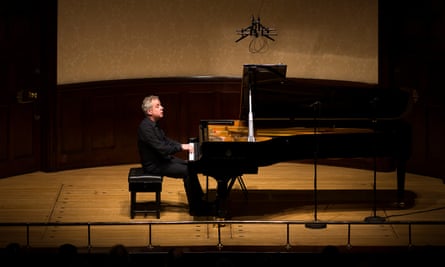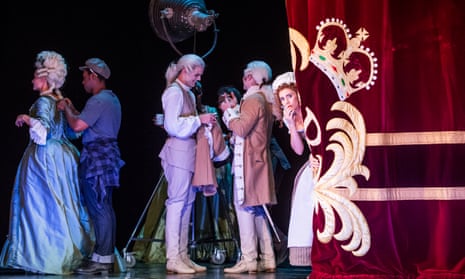What do women want? Less than you might think. When it comes to the Royal Opera’s new Così fan tutte, a work that addresses the question repeatedly, an awful lot less. Sometimes nothing at all would do perfectly. Here are some of the things women – men too, I dare say – may not want, or not all in the same production of Mozart’s two-act opera: a mock bewigged cast taking a mock bow before the curtain rises, the joke worn thin before the overture is over; a 1940s railway departure scene a la Brief Encounter which then ascends to the flies, wheels still showing like a dropped hem; the four lovers canoodling in a picnic spot in the garden of Eden with fat serpent curling up the tree of knowledge and melon-sized apples ripe for prelapsarian temptation.
There is more, far more, for the easily bored, in German director Jan Philipp Gloger’s staging, his first for Covent Garden, with set designs by Ben Baur. Here a shiny cocktail bar, there a Vegas-style proscenium with pink-knicker silk curtain and sugary fairy lights, and look, there’s a “baroque” theatre with painted sylvan forest and Guglielmo (Alessio Arduini) and Ferrando (Daniel Behle) in frock coats. Now we’re above stage, now below, beside, behind. Trap doors, dressing rooms, mannequins: all present too. This is also a film set with tripod lights that sometimes – you guessed it – swivel round to the audience. If I have another light beamed on me to remind me that life’s a stage and I, too, am a weak human being, I’ll enter a convent. There was so much to take in, not to say throw out, that by the end, a long time after the beginning, it was hard to remember what this most sublime opera was all about.
That’s odd because although the meaning and complexity of Mozart’s final collaboration with his librettist Da Ponte are inexhaustible, the plot is simple. Two pairs of lovers swap partners thanks to a dupe and a maid. In Così, all variations on love’s fickleness are possible, but not necessarily all worth acting out. However good the intention, this was Gloger’s mistake. There were touching moments in the mayhem. Conductor Semyon Bychkov’s tempi are leisurely and, as you might expect, the music is beautifully shaped, but with all the gaps for applause there was a danger of relaxed pliancy turning into lassitude.
The young cast, many making house debuts, took all in their stride and engaged fully, though the quality of singing does not quite reach top international levels. The standout moment was Behle’s sensational performance of Un’aura amorosa, the reprise hushed to the point of near silence. The German baritone Johannes Martin Kränzle made wise light of Alfonso’s meddling and needling, with Spanish soprano Sabina Puértolas a sharp, leather-wearing boho Despina. Two Americans, soprano Angela Brower (Dorabella) and mezzo-soprano Corinne Winters (Fiordiligi), a little too similar in vocal colour, had credible exuberance and well-matched charm. By the time Così is relayed live to cinemas on 17 October, these raw but attractive performances should have cooked nicely. An emergency injection of stillness might just save the show.
On Tuesday at the Barbican, the London Symphony Orchestra and chorus gave the second of two performances of Verdi’s Requiem, the first relayed live on the LSO’s new YouTube channel. Galvanising this choral colossus with characteristic fervour, the LSO’s new principal guest conductor Gianandrea Noseda forged forensic detail with long, overarching phrasing.

Despite over-English-sounding Latin, in contrast to that of the four Italian soloists, the LSC sang for their lives. Taking the Sanctus at a white-hot sprint – no hanging around here – Noseda coaxed from them superbly unified singing. In the ferocious Dies Irae they snapped and raged like fourscore angry dogs. Elsewhere they were nimble and ethereal. Whether in brass fanfares, operatic-like woodwind solos or pianissimo string writing, the orchestra always responded precisely to Noseda’s mix of grace and intensity.
The soloists contrasted rather than blended, the lower voices – mezzo-soprano Daniela Barcellona and baritone Michele Pertusi – absolutely attuned to the conductor’s demands, while soprano Erika Grimaldi and tenor Francesco Meli strayed, if inevitably in this work, too far towards the opera stage. Sometimes, in the fury of the moment, ensemble slipped a fraction. Yet this was an exhilarating evening and a ringing endorsement of Noseda’s appointment, were any needed.
Among virtuoso pianists, there are a few who wriggle out of the standard repertoire noose and run free. The Russian-German Igor Levit, who won the recording of the year award at this month’s Gramophone awards for his wild and ambitious Bach, Beethoven and Frederic Rzewski disc, is one. The American Jeremy Denk is another. He studied chemistry to a high level before settling for music, writing deftly about it as well as performing. In one of the opening concerts of Wigmore Hall’s new season he played a programme spanning medieval to modern, almost a mini-history of the invention of counterpoint and harmony, its breakdown in the early 20th century and its renewal – if you want to see it that way – via Philip Glass and Ligeti.

Music written before Bach is a virtual no-go area for pianists playing on modern concerts grands. Here, Denk made Machaut, Byrd, Gesualdo part of a continuum leading to Beethoven, Wagner (the Liszt transcription of the Liebestod from Tristan und Isolde, supremely well played) and Stockhausen. Since the early works were in some cases written for voices, this was not a history of pianism, but of music itself. Performing with delight and flair, Denk steamed through 24 pieces and six centuries, barely pausing between each, which kept the listener on the qui vive. Various styles elided, collided, colluded with or bumped against what came before or next.
Listen again on the Radio 3 iPlayer. Any tiny imperfection, or dissatisfaction with absorbing so much in such a short time, was absolved by the magnificence and boldness of the gesture. No wonder the audience rose to its feet as the last note sounded.
Star ratings (out of 5)
Cosi fan tutte ★★★
Verdi’s Requiem ★★★★
Jeremy Denk ★★★★

Comments (…)
Sign in or create your Guardian account to join the discussion